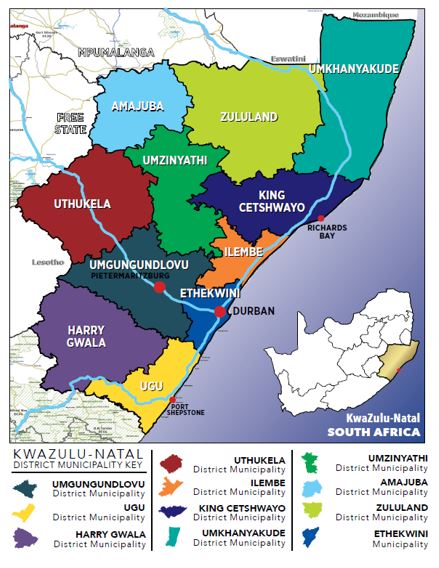KwaZulu-Natal In Context
Location
KwaZulu-Natal is one of the nine provinces in South Africa. Situated on the east coast of the country, KwaZulu-Natal neighbours three other provinces: Eastern Cape, Mpumalanga and the Free State. KwaZulu-Natal borders the countries of Mozambique and Eswatini in the north, and Lesotho in the south.
Area
The province is South Africa’s third smallest, taking up 7, 7% of the country’s land area and has a total area of 94 361 km².
Main cities and towns
Pietermaritzburg (Capital) Durban, Ulundi, Eshowe, Newcastle, Richards Bay
Municipalities
Local government in KwaZulu-Natal is organised into the eThekwini Metropolitan Council, and ten district municipalities, namely: Amajuba; iLembe; Harry Gwala; Ugu; uMgungundlovu; uMkhanyakude; uMzinyathi; uThukela; King Cetshwayo and Zululand. Each district is further divided into a varying number of local municipalities.
Climate
The summer-rainfall coastal regions are hot and humid, with a subtropical climate. The Midlands area is drier, with extremely cold conditions in winter and snow on the high-lying ground. In the north, the subtropical strip extends around Eswatini to the edge of the escarpment.
Population
The province is home to the largest percentage (20% of the South African population), an estimated 10,9 million people (2015). Statistics South Africa (Stats SA) estimated the mid-year population of the country as 55, 6 million in 2016.
Many of the people either live or work in fast developing first world urban centres with competitive infrastructure, or in very under resourced rural areas.
Principal Languages
The province comprises a multicultural mix of people and the principal languages are IsiZulu 82,5%; English 12,5%; and Afrikaans 13,2%
Monarchy
KwaZulu-Natal is the only province with a monarchy specifically provided for in the Constitution.
Infrastructure
Of major significance is that the ports of Durban and Richards Bay, around which KwaZulu-Natal is established, are two of Africa’s gateways to the sea lanes of the world. Durban and Richards Bay ports are southern Africa’s busiest in terms of handling cargo by value and bulk respectively. The Durban â€" Free State â€" Gauteng logistics and transport corridor forms the backbone of South Africa’s freight transportation network and is vital in facilitating economic growth for the country.
Special Economic Zones
The Dube TradePort is home to King Shaka International Airport which forms the heart of the first purpose-built aerotropolis in Africa and is destined to become a premier business and trade hub. The Dube TradePort is the only facility in Africa that brings together an international airport, a cargo terminal, warehousing, offices, a retail sector, hotels, and an agricultural area.
The Richards Bay Industrial Development Zone (RBIDZ) is a purpose built and secure industrial estate on the north-eastern South African coast. The N2 business corridor links the Province’s two major ports, Durban and Richards Bay, and connects with Maputo in Mozambique and, ultimately, areas of East Africa.
Economy
KZN is the second largest contributor to the economy of the country, generating a percentage share of national GDP of 16 per cent after Gauteng with a percentage share of GDP of 35.2%; this proves that the province plays a significant role in SA’s economy.
Economic Sectors
The province offers a competitive advantage in manufacturing, transport, storage and communications, as well as finance and business services. It is well positioned in agriculture, forestry and fishing, agricultural resource-intensive manufacturing and in the tourism and accommodation sectors.
Economic activity is concentrated in the metropolitan areas of Durban, Pietermaritzburg and Richards Bay.
Tourism
KZN has many tourist attractions: stunning mountainous areas, wildlife reserves (with big five animals â€" lion, elephant, buffalo, leopard, rhino) and beautiful beaches washed by the warm Indian Ocean. The province has two UNESCO World Heritage Sites: iSimangaliso Wetland Park and uKhahlamba Drakensberg Park.
Lifestyle
KZN comprises diverse people, a mixture of cultures, a relaxed coastal lifestyle with all necessary amenities and a business-friendly environment.

